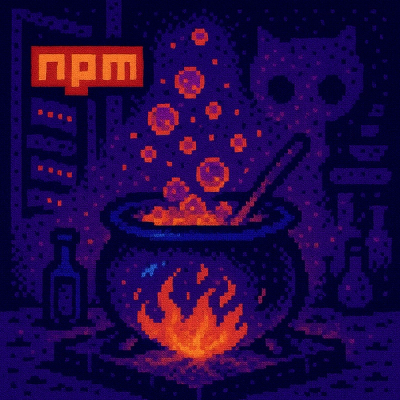
Security News
How Enterprise Security Is Adapting to AI-Accelerated Threats
Socket CTO Ahmad Nassri discusses why supply chain attacks now target developer machines and what AI means for the future of enterprise security.
@aws/app-framework-for-github-apps-on-aws
Advanced tools
Credential Manager is part of the [framework-for-github-app-on-aws](https://github.com/amazon-ospo/framework-for-github-app-on-aws) (The framework). It provides a secure and scalable solution for managing GitHub App credentials on AWS, with minimal custom
Credential Manager is part of the framework-for-github-app-on-aws (The framework). It provides a secure and scalable solution for managing GitHub App credentials on AWS, with minimal custom code.
The Genet Credential Manager is a nested CDK stack and Level 3 (L3) construct that helps you manage GitHub App credentials on AWS. It securely stores your app's private key, creates short-lived App Tokens using AWS KMS, and retrieves Installation Access Tokens. This removes the need to write custom authentication logic or directly manage sensitive keys. The component integrates with your CDK application and exposes well-defined APIs and permission grants for secure credential access. By placing this functionality behind a dedicated API, you not only simplify implementation but also gain an additional layer of fine-grained access control via IAM policies
The Credential Manager simplifies and secures GitHub App credential handling by providing:
GitHub Apps require a long-lived App Signing Key, which is used to generate short-lived App Tokens. These App Tokens are then used to request Installation Access Tokens that authorize API access to GitHub resources. While this flow is secure and scalable by design, it introduces operational and security risks. App Signing Keys are sensitive, and if stored improperly, they are vulnerable to accidental leaks or misuse. Because these keys can be used to generate unlimited App Tokens, any compromise could grant unauthorized access across all installations of the App.
The Credential Manager addresses these challenges by storing the signing key securely in AWS KMS-managed Hardware Security Modules (HSMs). It uses KMS signing to generate JWT-based App Tokens, so the key never leaves the secure boundary. The system exposes IAM-authenticated Lambda Function URLs that allow trusted components to retrieve App and Installation Access Tokens without handling or accessing the key directly. This design eliminates the need to embed key logic in your business code, reduces the attack surface, and enforces least privilege through fine-grained IAM controls.
Before using Credential Manager in your application, you must complete the following setup steps:
Deploy the Credential Manager CDK stack This provisions all required infrastructure including DynamoDB tables, Lambda functions.
Import your GitHub App's private key into AWS KMS Use the app-framework-ops-tool to securely import your GitHub App private key into KMS.
See the README.md for step-by-step instructions on importing your GitHub App key.
To use the Credential Manager in your CDK application,
simply add the CredentialManager L3 construct to your stack.
This provision all the necessary infrastructure,
including DynamoDB tables, Lambda functions, and KMS keys.
Use the provided methods to allow your Lambda functions
or other IAM principals to generate tokens.
These tokens are obtained by invoking the generated Function URLs
using Smithy clients in your business logic.
import { CredentialManager } from '@aws/app-framework-for-github-apps-on-aws';
class MyStack extends Stack {
constructor(scope: App, id: string) {
super(scope, id);
// Some component of your infrastructure that needs to get GitHub credentials.
const examplePrincipal: IGrantable = someLambdaFunction;
// Create the credential manager
const credManager = new CredentialManager(this, 'CredentialManager', {});
// You retrieve endpoints from credentialManager properties to pass into your Smithy client in your business logic.
const appTokenEndpoint: string = credentialManager.appTokenEndpoint;
const installationAccessTokenEndpoint: string = credentialManager.installationAccessTokenEndpoint;
// Grant token generation permissions to other resources
credManager.grantGetAppToken(examplePrincipal);
credManager.grantGetInstallationAccessToken(examplePrincipal);
}
}
Grants permission to invoke the App token generation endpoint:
grantGetAppToken(grantee: IGrantable): void
Grants permission to invoke the installation access token endpoint:
grantGetInstallationAccessToken(grantee: IGrantable): void
Grants permission to invoke the refresh cached data endpoint:
grantRefreshCachedData(grantee: IGrantable): void
Grants permission to invoke the installation record retrieval endpoint:
grantGetInstallationRecord(grantee: IGrantable): void
Creates a CloudWatch dashboard with two widgets:
A widget displaying the percentage of remaining rate limit for each GitHub App installation
An alarm that triggers when the remaining rate limit for any GitHub App installation falls below a specified threshold (default: 20%)
rateLimitDashboard({ limit?: number }): void
To interact with Credential Manager’s APIs, use the framework generated Smithy client. This client handles AWS SigV4 signing and request construction for both App Token and Installation Access Token APIs.
import { AppFrameworkClient } from '@aws/app-framework-for-github-apps-on-aws-client';
const client = new AppFrameworkClient({
endpoint: '<your deployed Lambda Function URL>',
region: '<your AWS region>',
credentials: '<your AWS credential provider>',
sha256: Sha256, // Sha256 hsing algorithm
});
import { GetInstallationTokenCommand } from '@aws/app-framework-for-github-apps-on-aws-client';
const command = new GetInstallationTokenCommand({
appId: '<your App ID>',
nodeId: '<your App installation target node_id>',
});
const response = await client.send(command);
const token = response.installationToken;
You can limit the token's access to specific repositories and
permissions using the scopeDown parameter:
import { GetInstallationTokenCommand } from '@aws/app-framework-for-github-apps-on-aws-client';
const command = new GetInstallationTokenCommand({
appId: '<your App ID>',
nodeId: '<your App installation target node_id>',
scopeDown: {
repositoryNames: ['repo1', 'repo2'], // Limit to specific repositories by name
repositoryIds: [123456, 789012], // Or limit by repository IDs
permissions: { // Specify which permissions to grant (e.g., contents, issues, pull_requests)
contents: 'read',
pull_requests: 'write'
}
}
});
const response = await client.send(command);
const token = response.installationToken; // Token with limited scope
const requestedScope = response.requestedScopeDown; // What you requested (if scoping was used)
const actualScope = response.actualScopeDown; // What GitHub actually granted
scopeDown.permissions - Object with permission keys and
'read'/'write'/'admin' values
scopeDown.repositoryNames - Array of repository names to limit
access
scopeDown.repositoryIds - Array of repository IDs to limit access
Note: The scopeDown parameter can only reduce permissions, not expand
them.
Your GitHub App must already have the requested permissions,
and the specified repositories must be accessible to the installation.
Invalid scope down parameters (non-existent repositories,
unauthorized permissions) will result in an error rather than a successful
response.
For a complete list of available permissions and detailed scoping parameters, see the GitHub API documentation for creating installation access tokens.
import { GetAppTokenCommand } from '@aws/app-framework-for-github-apps-on-aws-client';
const command = new GetAppTokenCommand({
appId: '<your App ID>',
});
const response = await client.send(command);
const token = response.appToken;
import { RefreshCachedDataCommand } from '@aws/app-framework-for-github-apps-on-aws-client';
const command = new RefreshCachedDataCommand({});
const response = await client.send(command);
import { GetInstallationDataCommand } from '@aws/app-framework-for-github-apps-on-aws-client';
const command = new GetInstallationDataCommand({
nodeId: '<your target node_id>',
});
const response = await client.send(command);
const installations = response.installations;
import { GetInstallationsCommand } from '@aws/app-framework-for-github-apps-on-aws-client';
const command = new GetInstallationsCommand({
nextToken: '<your nexttoken>'
maxResults: '<your maxResults>'
});
const response = await client.send(command);
const installations = response.installations;
nextToken and maxResults are optional parametersStores GitHub App IDs and their corresponding private key ARNs
Schema:
AppId (NUMBER)Configuration:
Tracks GitHub App installations with node_id, installation_id, and app_id
Schema:
AppId (NUMBER)NodeId (STRING)Global Secondary Indexes:
NodeID:
NodeId (STRING)AppId (NUMBER)InstallationID:
InstallationId (NUMBER)AppId (NUMBER)Configuration:
The App Token Generator is a Lambda function
that generates short-lived JWTs used to authenticate the GitHub App itself.
It exposes a Function URL with AWS IAM authentication
and performs RSA signing operations through KMS.
Access is restricted to IAM principals explicitly granted through grantGetAppToken.
The Installation Access Token Generator is a Lambda function
that retrieves GitHub Installation Access Tokens
for a specific installation of your GitHub App.
It is exposed through a Function URL with IAM authentication,
and access is controlled via grantGetInstallationAccessToken.
The Refresh Cached Data Lambda function
synchronizes installation data between GitHub and DynamoDB.
While the AppInstallation Table is automatically updated
by the installation tracker every 30 minutes,
this API gives you the ability to refresh cached data at any time on-demand.
It retrieves all App IDs from the App Table,
fetches current installations from GitHub,
and updates the Installation Table with refreshed timestamps.
It is exposed through a Function URL with IAM authentication,
and access is controlled via grantRefreshCachedData.
The Get Installation Data Lambda function
retrieves cached installation data from DynamoDB for a given nodeId.
It provides access to installation records without requiring GitHub API calls.
It is exposed through a Function URL with IAM authentication,
and access is controlled via grantGetInstallationRecord.
The Get Installations Lambda function
retrieves cached installation data from DynamoDB installations table.
It provides access to installation records without requiring GitHub API calls.
It is exposed through a Function URL with IAM authentication,
and access is controlled via grantGetInstallations.
Scans the GitHub App installation metadata every 30 minutes and updates the Installation Table. This ensures the table stays in sync with active installations and can be used to track installation lifecycles reliably.
Scans GitHub App Rate Limit usages every 10 minutes and generates corresponding metrics. These metrics are accessible through the rate limit dashboard. This enables proper tracking of API usage for each GitHub App.
Credential Manager stores your GitHub App signing key using AWS KMS. All signing operations are delegated to KMS, ensuring that the private key never leaves KMS-managed HSMs.
AWS KMS does not maintain the durability of imported key materials at the same level as key material that AWS KMS generates. In the unlikely event of certain region-wide failures that affect AWS KMS, your imported key material may need to be re-imported into a new KMS key. However, the impact in this use case should be low, because you can simply go to your GitHub App settings and generate a new private key, then re-import the new key into KMS to resume operation.
Metadata is stored in DynamoDB with Point-in-Time Recovery enabled,
and the App table uses a RETAIN removal policy
to prevent accidental data loss.
Function URLs require AWS IAM authentication, and only explicitly granted IAM principals can invoke them. Access to KMS keys is restricted via tag-based policies to enforce fine-grained permissions.
These AWS resources incur usage-based charges:
DynamoDB
Lambda
KMS
Important Note:
The App table's RETAIN removal policy means it will persist even if the stack is deleted, potentially leading to ongoing costs.
When you rotate App signing key, we do not automatically schedule the old key for deletion. You will need to schedule the old key for deletion. Failure to do so can result in ongoing KMS storage charges for unused keys.
The Credential Manager uses AWS resource tags for resource identification and access control instead of relying on static resource names. This approach provides better flexibility and control over resource management.
| Resource | Tag Key | Tag Value |
|---|---|---|
| Stack | FrameworkForGitHubAppOnAwsManaged | CredentialManager |
| App Table | CredentialManager | AppTable |
| Installation Table | CredentialManager | AppInstallationTable |
| Function URLs | CredentialManager | AppTokenEndpoint |
InstallationAccessTokenEndpoint | ||
RefreshCachedDataEndpoint | ||
InstallationCachedDataEndpoint | ||
InstallationsEndpoint |
The framework uses tags for controlling access to KMS keys. KMS signing permissions are restricted to keys with specific tags:
StringEquals: {
'aws:ResourceTag/FrameworkForGitHubAppOnAwsManaged': 'true',
'aws:ResourceTag/Status': 'Active'
}
FAQs
Credential Manager is part of the [framework-for-github-app-on-aws](https://github.com/amazon-ospo/framework-for-github-app-on-aws) (The framework). It provides a secure and scalable solution for managing GitHub App credentials on AWS, with minimal custom
The npm package @aws/app-framework-for-github-apps-on-aws receives a total of 6 weekly downloads. As such, @aws/app-framework-for-github-apps-on-aws popularity was classified as not popular.
We found that @aws/app-framework-for-github-apps-on-aws demonstrated a healthy version release cadence and project activity because the last version was released less than a year ago. It has 18 open source maintainers collaborating on the project.
Did you know?

Socket for GitHub automatically highlights issues in each pull request and monitors the health of all your open source dependencies. Discover the contents of your packages and block harmful activity before you install or update your dependencies.

Security News
Socket CTO Ahmad Nassri discusses why supply chain attacks now target developer machines and what AI means for the future of enterprise security.

Security News
Learn the essential steps every developer should take to stay secure on npm and reduce exposure to supply chain attacks.

Security News
Experts push back on new claims about AI-driven ransomware, warning that hype and sponsored research are distorting how the threat is understood.